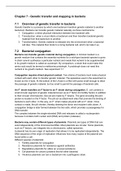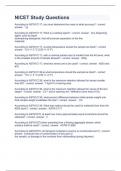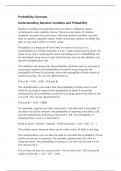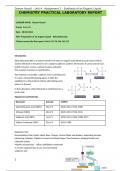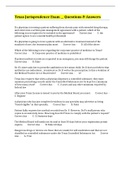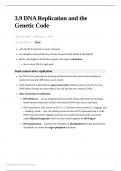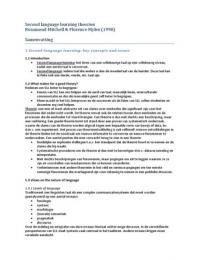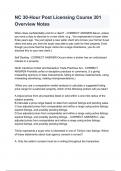Chapter 7 - Genetic transfer and mapping in bacteria
7.1 Overview of genetic transfer in bacteria
Genetic transfer is a process by which one bacterium transfers genetic material to another
bacterium. Bacteria can transfer genetic material naturally via three mechanisms:
1. Conjugation: a direct physical interaction between two bacterial cells
2. Transduction: when a virus infects a bacterium and then transfers bacterial genetic
material from that bacterium to another.
3. Transformation: Genetic material is released into the environment when a bacterial
cell dies. This material then binds to a living bacterial cell, which can take it up.
7.2 Bacterial conjugation
Bacteria can transfer genetic material during conjugation. A minimal medium is a
growth medium that contains the essential nutrients for a wild-type bacterial species to grow.
A strain cannot synthesize a particular nutrient and needs that nutrient to be supplemented
in its growth medium is called an auxotroph. By comparison, a strain that could make this
amino acid would be termed a methionine prototroph. A prototroph does not need this
nutrient in its growth medium. See experiment 7.1
Conjugation requires direct physical contact. Two strains of bacteria must make physical
contact with each other to transfer genetic material. The apparatus used in the experiment is
known as the U-tube. At the bottom of the U-tube is a filter with pores small enough to allow
the passage of genetic material, but too small to permit the passage of bacterial cells.
An F+ strain transfers an F factor to an F- strain during conjugation. E. coli contains a
small circular segment of genetic material known as an F factor (for fertility factor) in addition
to their circular chromosome. Sex pili are made by F+ strains. The gene encoding the pilin
protein is located on the F factor. The pili act as attachment sites that promote the binding of
bacteria to each other. In this way, an F+ strain makes physical with an F- strain. Once
contact is made, the pili shorten, thereby drawing the donor and recipient cells closer. A
conjugation bridge is later formed between the two cells, which provides a passageway for
DNA transfer.
The complex between the single-stranded DNA and relaxase is called a nucleoprotein
because it contains both nucleic acid (DNA) and protein (relaxase).
Bacteria may contain different types of plasmids. Plasmids are types of DNA that can
exist independently of the chromosomal DNA. Most plasmids are circular. Some plasmids,
such as F factors, can integrate into a chromosome, called episomes.
A plasmid has its own origin of replication that allows it to be replicated independently. The
DNA sequence of the origin of replication influences how many copies of the plasmid are
found within a cell.
Different species of plasmids:
1. Fertility plasmids for conjugation
2. Resistance plasmids for resistance against antibiotics
3. Degradative plasmids for utilize an unusual substance
4. Col-plasmids for colicins (proteins that kill other bacteria)
5. Virulence plasmids can turn a bacterium into a pathogenic strain.
7.1 Overview of genetic transfer in bacteria
Genetic transfer is a process by which one bacterium transfers genetic material to another
bacterium. Bacteria can transfer genetic material naturally via three mechanisms:
1. Conjugation: a direct physical interaction between two bacterial cells
2. Transduction: when a virus infects a bacterium and then transfers bacterial genetic
material from that bacterium to another.
3. Transformation: Genetic material is released into the environment when a bacterial
cell dies. This material then binds to a living bacterial cell, which can take it up.
7.2 Bacterial conjugation
Bacteria can transfer genetic material during conjugation. A minimal medium is a
growth medium that contains the essential nutrients for a wild-type bacterial species to grow.
A strain cannot synthesize a particular nutrient and needs that nutrient to be supplemented
in its growth medium is called an auxotroph. By comparison, a strain that could make this
amino acid would be termed a methionine prototroph. A prototroph does not need this
nutrient in its growth medium. See experiment 7.1
Conjugation requires direct physical contact. Two strains of bacteria must make physical
contact with each other to transfer genetic material. The apparatus used in the experiment is
known as the U-tube. At the bottom of the U-tube is a filter with pores small enough to allow
the passage of genetic material, but too small to permit the passage of bacterial cells.
An F+ strain transfers an F factor to an F- strain during conjugation. E. coli contains a
small circular segment of genetic material known as an F factor (for fertility factor) in addition
to their circular chromosome. Sex pili are made by F+ strains. The gene encoding the pilin
protein is located on the F factor. The pili act as attachment sites that promote the binding of
bacteria to each other. In this way, an F+ strain makes physical with an F- strain. Once
contact is made, the pili shorten, thereby drawing the donor and recipient cells closer. A
conjugation bridge is later formed between the two cells, which provides a passageway for
DNA transfer.
The complex between the single-stranded DNA and relaxase is called a nucleoprotein
because it contains both nucleic acid (DNA) and protein (relaxase).
Bacteria may contain different types of plasmids. Plasmids are types of DNA that can
exist independently of the chromosomal DNA. Most plasmids are circular. Some plasmids,
such as F factors, can integrate into a chromosome, called episomes.
A plasmid has its own origin of replication that allows it to be replicated independently. The
DNA sequence of the origin of replication influences how many copies of the plasmid are
found within a cell.
Different species of plasmids:
1. Fertility plasmids for conjugation
2. Resistance plasmids for resistance against antibiotics
3. Degradative plasmids for utilize an unusual substance
4. Col-plasmids for colicins (proteins that kill other bacteria)
5. Virulence plasmids can turn a bacterium into a pathogenic strain.


